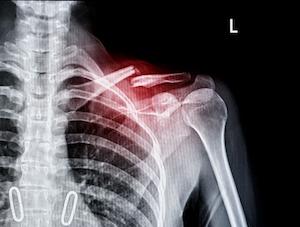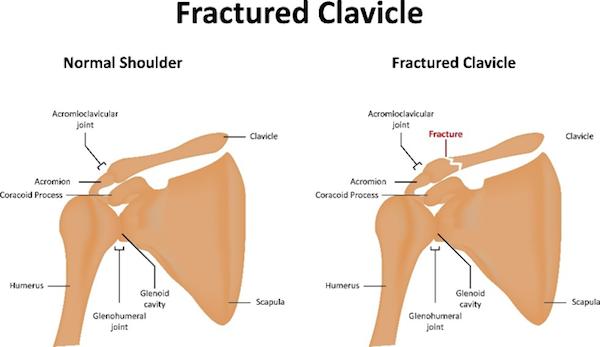Clavicle Fractures
Attorneys for Victims Who Have Suffered a Clavicle Fracture From Car Accidents, Slip and Falls, and Sports Injuries Throughout Illinois
What is a Clavicle Fracture?

The clavicle (collar bone) is located over the top of the chest and between the sternum (breastbone) and the scapula (shoulder blade). The sternal end of the clavicle connects with the sternum at the sternoclavicular joint, and its acromial end connects with scapula at the acromioclavicular joint. The clavicle connects the arm to the body via the sternoclavicular and acromioclavicular joints and helps to stabilize the shoulder and arm as they move. Clavicle fractures are common, constituting 5% to 10% of all fractures and 35% of all shoulder injuries. A fractured clavicle can be painful and can make it difficult to move your arm. Proper evaluation and diagnosis by your physician can help ensure that the clavicle heals in anatomical alignment, preventing future loss of function or limited mobility of the shoulder and arm. It is important to seek medical attention as soon as possible if you believe you may have fractured your clavicle.
How Does a Clavicle Fracture Occur?
A direct blow to the shoulder is the most common cause of a clavicle fracture. This can occur during slip and falls, sports-related injuries, and trauma from motor vehicle accidents. Falling onto an outstretched arm can also cause a clavicle fracture.
What is a Clavicle Fracture Settlement Worth?
The settlement value of a clavicle fracture may be difficult to determine before reviewing the medical evidence, such as medical records and bills, and having an understanding of the theory of liability. The value of clavicle fractures can vary from case to case, depending on the severity of the fracture, the likelihood of permanency (such as a “bump” in the clavicle), and the treatment provided. Generally, damages for past and future pain and suffering, loss of a normal life, past and future medical bills, and wage loss can be obtained in a clavicle fracture settlement. However, a clavicle fracture injury settlement can be diminished based on whether a plaintiff’s own negligence (or “comparative fault”) contributed to the injury, or when there are pre-existing medical conditions that may also have led to the injury or need for treatment.
Some of Our Firm’s Recent Clavicle Fracture Settlements
Motor vehicle accident, negligence. Arizona. Settlement for $150,000 was reached on behalf of a client involved in a violent head-on collision. As a result of the collision, the woman suffered a comminuted displaced mid-shaft clavicle fracture. Given the degree of the displacement, the woman was required to undergo open reduction and internal fixation surgery.
Motor vehicle accident, negligence. DuPage County, Illinois. Settlement for $100,000 was reached on behalf of a victim of a T-bone collision. As a result of the car accident, the victim suffered a mid-clavicle fracture. Settlement was reached with the at-fault party’s insurance carrier, First Acceptance Insurance, and the victim’s underinsurance carrier, Progressive Insurance Company.
Motor vehicle accident, negligence. Will County, Illinois. Settlement for $92,500 was reached on behalf of a client involved in a T-bone collision. As a result of the collision, the man suffered a closed clavicular fracture with comminution and displacement, which required surgery. Settlement was reached pre-suit with the at-fault party’s insurance carrier, State Farm Insurance Company.
What are the Symptoms of a Clavicle Fracture?
Symptoms of a clavicle fracture may vary depending on the severity and type of fracture. Signs and symptoms that can accompany a clavicle fracture include:
- Pain that worsens with movement of the shoulder and arm
- Tenderness
- Swelling and bruising over the clavicle that may extend to the chest and armpit area over time
- Limited range of motion of the shoulder and arm due to pain and swelling
- Sagging of the shoulder downward and forward
- A grinding sensation with movement of the shoulder and/or arm
- A bump or bulge at the site of the fracture
- A numbness or tingling sensation down the arm
How is a Clavicle Fracture Diagnosed?
Initially, your physician will perform a physical examination as part of the diagnostic process. This physical examination will include palpating the clavicle to help locate the site of the fracture as well as performing a neurovascular and lung exam to ensure that no damage to the lungs, nerves, or blood vessels occurred during the fracture. Along with a physical exam, your physician will order an x-ray to determine the type of fracture. Typically, a clavicle fracture can be confirmed with just x-ray imaging, however, your physician may order a computed tomography scan (CT scan) to provide more detailed images of a more complex fracture.
Types of Clavicle Fractures
Clavicle fractures are classified based on the location of the fracture on the clavicle bone. The three classifications are:
Mid-shaft clavicle fractures: Mid-shaft clavicle fractures are the most common type of clavicle fractures, constituting 75% of all clavicle fractures, and are classified as such when the fracture occurs in the middle one-third of the clavicle bone.
Distal clavicle fractures: Distal clavicle fractures are the second most common type of clavicle fractures, constituting 20% of all clavicle fractures, and are classified as such when the fracture occurs in the distal one-third end of the clavicle bone. The distal end of the clavicle is located near the shoulder and connects to the scapula (shoulder blade) via the acromioclavicular joint.
Medial clavicle fractures: Medial clavicle fractures are the least common type of clavicle fractures, constituting 5% of all clavicle fractures, and are classified as such when the fracture occurs in the medial one-third end of the clavicle bone. The medial end of the clavicle is located near the sternum (breastbone) and connects to the manubrium of the sternum via the sternoclavicular joint.

Treatments for Clavicle Fractures
The majority of clavicle fractures can be treated through conservative, non-surgical methods. However, more complex fractures such as an open fracture (the fractured bone has broken through the skin) or a comminuted fracture (the bone has broken into two or more pieces) may require surgical intervention for proper healing.
Non-surgical treatment options: Restricting the movement of any fractured bone is critical for proper healing. Immobilization of the clavicle can be achieved by wearing an arm sling. As long as the fractured clavicle remains in anatomical alignment, then an arm sling may be all that is needed to keep your arm and shoulder in position while the fractured clavicle heals.
Surgical treatment options: If the fractured clavicle becomes displaced, breaks through the skin, or is fractured into multiple pieces, then surgical intervention will likely be required to realign the clavicle into its correct anatomical position. This process is called open reduction (realignment of the bone fragments through surgical intervention). Once the fractured clavicle is realigned, further surgical intervention may be required to maintain alignment in a process called internal fixation. Internal fixation devices, such as metal pins, screws, metal plates and stabilizing rods, may be used to maintain proper alignment and stability during the healing process.
After the arm sling or internal fixation devices are removed, most patients will require rehabilitation exercises and/or physical therapy to restore muscle strength, joint motion, and flexibility.
Contact the Illinois Personal Injury Lawyers at John J. Malm & Associates
The knowledgeable Illinois injury attorneys at John J. Malm & Associates have successfully handled complicated cases for our clients who have suffered clavicle fractures. We are a team of experienced personal injury lawyers who represent individuals and families throughout Illinois who have suffered an injury or loss due to an accident. You may be entitled to a substantial settlement if you have been injured. Call 630-527-4177, or 630-524-2323, and speak with Attorney John J. Malm and his team today.









